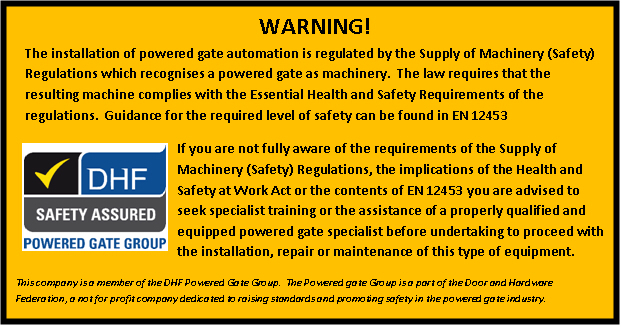Information
-
Client / Site
-
Site address
-
Document No.
-
Prepared by
-
Location
-
Conducted on
Operation and Maintenance Manual
Installation Diagram and Risk Assessment
-
Gates - swing
-
Potential Hazard areas
-
A - Impact / Crushing on main closing edge
-
B - Impact / Crushing in the arc/area of opening
-
C - Impact in the area of closure
-
D - Crushing in the area of hinge
-
E - Dragging of feet in lower edge of gate
-
F - Dragging on drive unit
-
G - Dragging, hooking or cutting on shape of mobile leaf
-
The risks have been assessed for this set of gates and the following control measures applied:
-
Gates - slide
-
Potential Hazard areas
-
A - Impact / Crushing on leading edge of the closing
-
B - Impact / Crushing in the opening area
-
C - Conveying, hook and shear during the movement due to the modelling of mobile leaf
-
D - Conveyance of hands
-
E - Conveying feet on the bottom edge of the gate
-
F - Conveyance of hands on the drive group
-
The risks have been assessed for this set of gates and the following control measures applied:
-
Gates - folding
-
Potential Hazard areas
-
A - Impact / Crushing on leading edge of the closing
-
B - Impact / Crushing in the opening area
-
C - Conveying, hook and shear during the movement due to the modelling of mobile leaf
-
D - Conveyance of hands
-
E - Conveying feet on the bottom edge of the gate
-
F - Conveyance of hands on the drive group
-
The risks have been assessed for this set of gates and the following control measures applied:
-
Barriers
-
Potential Hazard areas
-
A - Impact / Crushing on leading edge of the closing
-
B - Shearing / trapping and cutting between the beam and the drive unit
-
C - Risk of lifting
-
D - Risk of impact, crushing and conveying due to the movement of the beam counterweight
-
The risks have been assessed for this set of gates and the following control measures applied:
-
Bollards
-
Potential Hazard areas
-
A - Impact / Crushing on leading edge of the closing
-
B - Shearing / trapping and cutting between the beam and the drive unit
-
C - Risk of lifting
-
D - Risk of impact, crushing and conveying due to the movement of the beam counterweight
-
The risks have been assessed for this set of gates and the following control measures applied:
Engineer Review of Risk Assessment and alterations
-
Confirm that the system as installed meets projected installation and safety system design?
-
List details of changes and reasoning (against points a,b,c etc)
-
Action Taken
-
Residual Risks
Parts and Equipment
Parts and Equipment
-
Gates and posts
Equipment
-
Control Unit (Manufacturer / Model / Location)
-
Operator (s) (Manufacturer / Model / Location)
-
Radio Receiver (Manufacturer / Model / Location)
-
Other accessories / devices
-
Locking
-
Activation Equipment
-
Other
-
System Settings (Pause time / Open Run Time / Close Run Time)
-
Manual Key Type
-
Manual Operation - See Equipment Manual
CE Test Report
CE Testing Report
-
The following tests have been carried out and the systems passed
-
Risk assessment and variations list complete
-
Site and fixings posts/area suitable
-
Automation is not detrimental to gates
-
Correct component assembly
-
Fixing of UKCA Marking plate
-
Mechanical safety guards (if applicable)
-
System connected to isolator and user informed
-
Unpowered opening and closing ok
-
Open and closed position stops fitted
-
Emergency Manual over ride(s) tested OK
-
Fire Drop Unit tested OK
-
Safety devices all tested OK
-
Adjustments and settings to suit site conditions
-
All operational devices tested OK
-
Performance within manufacturers advertised specification
-
Noise levels OK
-
Absence of any any hazardous emissions
-
Absence of damage and deformation to gates and automation equipment
-
All screws, nuts, fixings in places and checked
-
Site cleared
-
FORCE MEASUREMENT TESTS COMPLETED
-
The above tests have been carried out and system is installed to be safe in accordance with this manual, current legislation and best practice.
-
Engineer
Declaration of Conformity
Declaration of Conformity
-
UKCA Declaration of Conformity
The system as detailed in this manual complies with the following legal directives and standards, best practice and safe usage guides where specifically available and understood by the installation company.
In accordance with BS EN13241-1:2011
We * (SCCI Alphatrack Ltd)
of * (Piper House, 14 West Place, West Road, Harlow, Essex, CM20 2GY)
in accordance with the following directive(s), legislation and standards
· BS EN13241-1:2011 ‘Umbrella’ standard from the Machinery Directive MD2006/42/EC for installation, testing and ongoing compliance of automatic gates and door systems
· BS EN12453:2001 Defines the crushing points, shear and pull-in areas of automatic gate and door systems and stipulates the allowable impact force on an object or person.
· BS EN12445:2001 Specifies testing points on gates and doors. Defines the distance and locations that testing of force must be carried out to comply
· BS EN12978:2009 Defines the self-test and monitoring characteristics of the transmission system.
· BS EN1760-2:2009 Defines level of sensitivity, performance characteristics, response time and percentage of sensitive surface areas.
· EN 12453:2000 - Intended as a supporting standard to EN 13241-1, this nevertheless established the state of the art regarding safety of powered doors and gates. EN 13241-1:2003 – Harmonised product standard under both the Machinery Directive and the Construction Products Directive. Powered door safety requirements based on EN 12453. Compliance with EN 13241-1 gives a presumption of conformity with the directives.
· The Health and Safety Executive Safety Notices - OPSTD 1-2011, FOD 7-2010, FOD WSW 1-2010
· Health and Safety at Work Act 1974
· Supply of Machinery (Safety) Regulations 1992 [EU Machinery Directive]
· Supply of Machinery (Safety) Regulations 2008 [as amended 2011]
The validity refers to what is performed and used by the declarant for the construction and operation of the mentioned product. Validity is lost in the following cases:
A) Changes made to the product that are unauthorised by the declarant in writing
B) the undertakings are established by the declarant and regarding the maintenance of suitable safety and good operating standards, provided for by law, are not respected.
C) in the event of improper use of the product -
-
Declarant Signature
Safety Instructions
Safety Instructions
-
When correctly installed in compliance to installation instructions and adhering to all current electrical, mechanical and manufacturers' regulations, the automation systems will provide a high degree of safety and problem free operation.
-
PLEASE NOTE THE FOLLOWING WARNINGS THAT MUST BE FOLLOWED IN ORDER TO PREVENT ACCIDENTS DURING SYSTEM OPERATION:
DO NOT ALLOW CHILDREN TO PLAY ON OR NEAR THE SYSTEM
KEEP ALL OPERATING DEVICES OUT OF THE REACH OF CHILDREN
DO NOT PASS THROUGH THE AREA OF OPERATION UNTIL THE SYSTEM IS FULLY OPEN
DO NOT STOP IN THE AREA OF OPERATION
OPERATE REMOTE CONTROLS, IF POSSIBLE, WITH VIEW OF THE SYSTEM
DO NOT INTERFERE WITH OR TRY TO STOP OPERATION OF SYSTEM
DO NOT ATTEMPT ANY ALTERATIONS TO ANY PART OF THE SYSTEM OPERATION OR LAYOUT
ENSURE THAT THE SYSTEM IS SERVICED AT LEAST TWICE ANNUALLY BY A SUITABLE SERVICE COMPANY
IN THE EVENT OF MALFUNCTION YOU MUST TURN SYSTEM POWER OFF AND LEAVE OPEN AND REPORT MALFUNCTION OR REQUIRED REPAIR IMMEDIATELY TO SERVICE COMPANY
YOU MUST CALL YOUR SERVICE COMPANY IF YOU HAVE DOUBTS REGARDING THE OPERATION AND SAFETY OF THE SYSTEM.
User Guide
User Guide
-
Normal System Operation
Operating signal (see list of activation equipment) will give start command to control unit which will open system to fully open position - (any locks will be automatically operated). The system will remain fully open for a pre-fixed time (pause time) before automatically closing fully. -
Isolating Power to the System: Local
-
Isolating Power to the System: Distributor / board
-
MANUAL OPERATION
Putting the system into operation;
1) Isolate power to the system
2) Release any keyed lock using key
3) Manually release operator(s) using key supplied
4) Put system to open position
Re-instating automatic operation
1) Check that power is still isolated
2) Re-engage the operator using the key supplied
3) Re-instate power supply at the isolator
4) Run the system to ensure operating correctly - you must wait for the duration of a complete open/closed cycle
If in any doubt about re-instating please call your service company -
Photograph 1
-
Photograph 2
-
Photograph 3
-
Photograph 4
-
Photograph 5
-
Photograph 6
Safety Accessories Activation
Safety Accessories Activation
-
The active infra red beams are installed to prevent the gate from operating if the beams are obstructed.
Beams set for closing - If the beams are obstructed as gates are closing, the gates will stop and fully open. They will not close until the obstruction is fully removed. The system will reset when the obstruction is removed and the gates have closed normally.
Beams set or opening - If the beams are obstructed as the gates are opening, the gates will stop and fully close. They will not open until the obstruction is removed.
Safety Edges - These are an additional safety feature.
If the safety edge is activated (by moving onto or against a person or an object) during opening the gate will stop and reverse. If the safety edge is activated during closing the gate will stop and reverse.
Handover Checklist
Handover Checklist
-
NOTE TO USER / OPERATOR / CLIENT
This checklist should be checked by you to ensure that you are completely satisfied with the finished installation. You should note any items missing, damaged, incomplete or not operating correctly. You should also note any items that cannot be assessed / checked as they have not yet been installed or completed. -
The following have been explained to you:
-
The activation devices / equipment for the system
-
How to operate the system in normal operation using operating devices / systems
-
How to isolate the power to the system
-
How to manually release the system
-
The safety instructions associated with the use of he system
-
The hazards associated with the system
-
The safety features and accessories included in the system
-
The system operating mode / method
-
The following items have been checked
-
The motors operate smoothly and without unusual noise
-
The gate(s), post(s) and hinges are without faults
-
The control panel housing is whole and secures correctly
-
All safety accessories / devices as listed fitted and working correctly
-
All activation devices / systems operate correctly
-
The gate(s) move through operating area without any obstruction
-
All wiring is concealed correctly and not exposed to elements
-
UKCA Conformity plate is fitted
-
You have been supplied with the following
-
A full copy of this document
-
Description of hazards applicable to your installation
-
UKCA Declaration of Conformity
-
Engineer testing report
-
User guide and manual procedure guide
-
Manual operation keys
-
Keys to any locks on gates if applicable
-
I confirm that the product works, is suitable and is accepted and that I have received instruction for use and maintenance, and will ensure that these are read and made available to all persons authorised to use the system.
-
I undertake to ensure that the system is used correctly and is maintained in good working order and condition as per the provisions in this manual
-
Engineer Signature
Scheduled Maintenance Log
Scheduled Maintenance Log
-
Date
-
Service company
-
Action Taken
-
Date
-
Service company
-
Action Taken
-
Date
-
Service company
-
Action Taken
-
Date
-
Service company
-
Action Taken
Warranty
Duration and Terms & Conditions
-
There is a one year on site warranty on all parts supplied, installed and commissioned as described in the final equipment list.
The warranty period is 12 months from the date of signed handover.
The warranty covers fair wear and tear in normal use or equipment failure that is not due to any of the listed exclusions. The warranty covers materials, parts and labour subject to the following exclusions and provided the required procedures for mitigating damage are met.
EXCLUSIONS
a) Works required through misuse, abuse, neglect, theft, fire, flood, lightning, air conditioning or humidity control failure, power fluctuations, electrical interference, accidental or deliberate damage (however caused), change of location or failure of system or equipment for any other reason other than normal use.
b) Repair or maintenance made by impractical by through denial of access, alterations made by others, or connection of system to other electrical or mechanical equipment or devices.
c) Relocation of the system
d) Works occasioned by attempts to maintain, move, or in any way alter or interfere with the system by you or a third party
e) Design changes necessitated through change of use, or to ensure compliance with any requirements of a regulatory body.
f) Consequent damage of any kind
g) Additional damage due to the failure to report system faults / problems
h) Any additional damage due to the failure to put system to manual operation on discovery of fault / problem
In the event of system fault, failure or incorrect operation of any kind, the system MUST be switched off at mains supply, operators put to manual operation and gates fully opened. Our service department must be advised immediately of the nature of the problem and the gate(s) can only be used manually until such a time as an engineer has attended and resolved the issue. Failure to meet this procedure will be a breach of the guarantee conditions and any subsequent required parts or works may be chargeable.
















